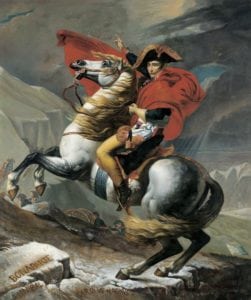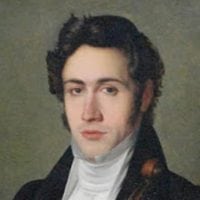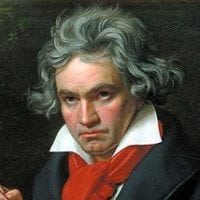Ludwig van Beethoven
Symphony No. 3 in E-flat major, Op. 55, “Eroica”
 Ludwig van Beethoven was an early admirer of Napoleon Bonaparte, whose early exploits as First Consul of France reaffirmed the motto of the French Revolution, “Liberty, Equality, Fraternity.” It had been Beethoven’s intention to dedicate his third symphony to Napoleon, but when Beethoven heard that Napoleon had declared himself Emperor in May 1804, he was outraged. So vehement was Beethoven’s desire to rid his third symphony of any association with the French general that he erased the words “intitulata Bonaparte” from the title page with a knife, which left a hole in the paper. When the score was first printed in 1806, the title page read only, “A heroic symphony … composed to celebrate the memory of a great man.”
Ludwig van Beethoven was an early admirer of Napoleon Bonaparte, whose early exploits as First Consul of France reaffirmed the motto of the French Revolution, “Liberty, Equality, Fraternity.” It had been Beethoven’s intention to dedicate his third symphony to Napoleon, but when Beethoven heard that Napoleon had declared himself Emperor in May 1804, he was outraged. So vehement was Beethoven’s desire to rid his third symphony of any association with the French general that he erased the words “intitulata Bonaparte” from the title page with a knife, which left a hole in the paper. When the score was first printed in 1806, the title page read only, “A heroic symphony … composed to celebrate the memory of a great man.”
Today, the Eroica is considered one of the groundbreaking musical events of the 19th century, but in Beethoven’s time it received a great deal of criticism. Its length alone challenged the audience (depending on the conductor’s tempos and observations of marked repetitions in the score, the Eroica runs 45–60 minutes). Beethoven acknowledged this, noting in the 1806 edition of the score, “This symphony being purposely written much longer than is usual, should be performed nearer the beginning rather than at the end of a concert … if it is heard too late it will lose for the listener, already tired by previous performances, its own proposed effect …”
One critic complained, “In this composition [there is] too much that is glaring and bizarre, hindering greatly one’s grasp of the whole.” Another reviewer, using words that today we would consider praiseworthy, criticized Beethoven’s “undesirable originality.” The critic went on to say, “Genius proclaims itself not in the unusual and fantastic but in the beautiful and sublime” and further, that the symphony as a whole was “unendurable to the mere music-lover.” From our vantage point at the beginning of the 21st century, we can recognize Eroica’s importance. Similar in its impact to Igor Stravinsky’s Rite of Spring, the influence of Eroica reverberated in all the symphonic music of the century that followed it.
Beginning with the one-two punch of the opening chords of the Eroica, Beethoven obliterated the concept of the Classical-style symphony and earned for himself the adjective “revolutionary.” Everything about this lengthy first movement confounds expectation: its unexpected and continuous development of melodic fragments, its “wrong key” tonalities, and Beethoven’s idiosyncratic use of rhythm, which at times verges on the eccentric. Certainly this was shocking to audiences accustomed to the more predictable pace of Wolfgang Amadeus Mozart and Joseph Haydn. Of particular note is the notoriously “early” entrance of the horn towards the end of the first movement.
Beethoven’s student and biographer Ferdinand Ries recalled, “At the first rehearsal of the Symphony, which was terrible — but at which the horn player made his entry correctly — I stood beside Beethoven and, thinking that a blunder had been made I said: ‘Can’t the damned hornist count? — it sounds horribly false!’ I think I came pretty close to getting a box on the ear. Beethoven did not forgive that little slip for a long time.”
The solemn, majestic Marcia funebre (funeral march) can be heard as Beethoven mourning his disappointment in Napoleon, and his vanished dreams of heroism.
The buoyant Scherzo and trio leaves the intensity of the previous two movements behind. Here is Beethoven’s mocking sense of humor at play, as when the strings return with their signature theme and stomp all over their previously playful rhythm. The insistent pulse of the strings and the incessant bounce of this movement continue the Eroica’s enormous reserves of energy; the music is like a puppy chasing its own tail.
The final movement, a set of themes and variations, uses music from the Beethoven’s own Overture to The Creatures of Prometheus from 1801 and an 1802 solo piano work, known today as the Eroica Variations. A virtuoso blast from the horn section signals the symphony’s conclusion, a glorious reaffirmation of Beethoven’s heroic ideals.
At a Glance
- Work composed: 1802-04. Dedicated to Beethoven’s patron, Prince Franz Joseph Maximilian Lobkowitz.
- World premiere: Beethoven conducted the premiere on April 7, 1805 in Vienna’s Theater an der Wien.
- Instrumentation: 2 flutes, 2 oboes, 2 clarinets, 2 bassoons, 3 horns, 2 trumpets, timpani and strings.
- Estimated duration: 47 minutes



 Ludwig van Beethoven was an early admirer of Napoleon Bonaparte, whose early exploits as First Consul of France reaffirmed the motto of the French Revolution, “Liberty, Equality, Fraternity.” It had been Beethoven’s intention to dedicate his third symphony to Napoleon, but when Beethoven heard that Napoleon had declared himself Emperor in May 1804, he was outraged. So vehement was Beethoven’s desire to rid his third symphony of any association with the French general that he erased the words “intitulata Bonaparte” from the title page with a knife, which left a hole in the paper. When the score was first printed in 1806, the title page read only, “A heroic symphony … composed to celebrate the memory of a great man.”
Ludwig van Beethoven was an early admirer of Napoleon Bonaparte, whose early exploits as First Consul of France reaffirmed the motto of the French Revolution, “Liberty, Equality, Fraternity.” It had been Beethoven’s intention to dedicate his third symphony to Napoleon, but when Beethoven heard that Napoleon had declared himself Emperor in May 1804, he was outraged. So vehement was Beethoven’s desire to rid his third symphony of any association with the French general that he erased the words “intitulata Bonaparte” from the title page with a knife, which left a hole in the paper. When the score was first printed in 1806, the title page read only, “A heroic symphony … composed to celebrate the memory of a great man.”
